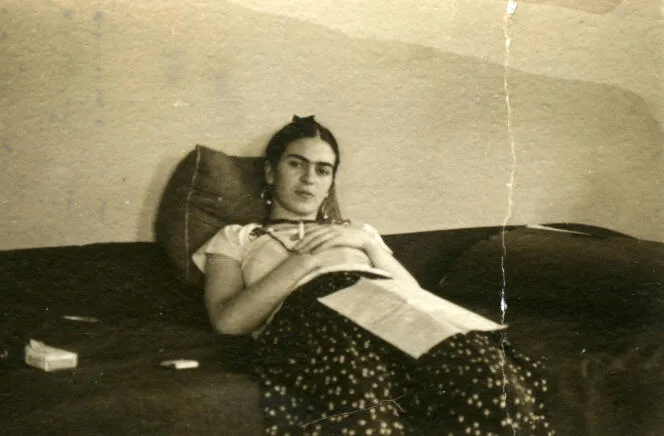The Iconic Life of Frida Kahlo Frida Kahlo remains one of the most celebrated and influential artists of the 20th century. Her life, marked by pain, resilience, and unapologetic self-expression, has inspired generations worldwide. Known for her surreal self-portraits and Mexican folk art influence, Frida's art transcends boundaries of culture, gender, and identity. In this blog, we explore the lesser-known aspects of her life, iconic works, and her lasting legacy on art, feminism, and pop culture.
Picture shows_Frida Kahlo, 1932
From Dreams to Struggles Born on July 6, 1907, in Coyoacán, Mexico, Magdalena Carmen Frida Kahlo y Calderón grew up amid Mexico's political revolution. Her father, Guillermo Kahlo, a German photographer, introduced her to art and creativity at an early age. Despite her spirited nature, Frida's life took a tragic turn at just six years old when she contracted polio. This illness left her with a limp, yet she refused to let it limit her, showcasing her strength and resilience early on.
A life-altering event came in 1925 when a horrific bus accident fractured her spine, pelvis, and legs. Confined to bed for months, Kahlo turned to painting as a way to channel her physical and emotional pain. Little did the world know, her artistry would eventually redefine Mexican art, surrealism, and global feminism.
Frida's Artistic Style: The Language of Pain and Passion Frida Kahlo's paintings are deeply personal and emotional, often reflecting themes of pain, suffering, love, and identity. Her work combined elements of Mexican folk art with surrealism, creating vibrant, colorful pieces that spoke universal truths.
- Self-Portraits by Frida Kahlo: Frida painted over 50 self-portraits during her career, most famously Self-Portrait with Thorn Necklace and Hummingbird (1940) and The Two Fridas (1939). Each piece mirrors her physical agony and emotional struggles while depicting her resilience and strength.
- Symbolism in Frida Kahlo Paintings: Kahlo used animals, plants, and indigenous Mexican symbols in her work. Monkeys, flowers, skulls, and bright colors often represent fertility, life, and death in her paintings.
- Surrealist Artist Frida Kahlo: Though often labeled a surrealist, Frida rejected this title, famously saying, "I never paint dreams. I paint my own reality." Her art remains raw, intimate, and boldly honest.
Frida and Diego Rivera: A Tumultuous Love Story In 1929, Frida Kahlo married Diego Rivera, a renowned Mexican muralist. Their relationship was a stormy mix of deep love, infidelity, and mutual admiration. Diego's larger-than-life persona and Frida's fiery independence clashed, but their connection remained unshakable.
Kahlo's personal struggles, including miscarriages and Diego's affairs, often surfaced in her art. Paintings like Henry Ford Hospital (1932) and A Few Small Nips (1935) reflect her emotional and physical anguish. Despite their tumultuous relationship, Diego Rivera admired Frida's talent and supported her artistic journey.
Frida Kahlo: A Feminist and Cultural Icon Long before the feminist movement gained momentum, Frida Kahlo broke barriers by unapologetically expressing herself. Through her art and lifestyle, she challenged societal norms about gender, beauty, and identity:
- Frida embraced her indigenous Mexican roots, wearing traditional Tehuana dresses and rejecting Eurocentric beauty standards.
- She explored themes of female pain, motherhood, and sexuality in her paintings, giving a voice to women's experiences that were often overlooked.
- Kahlo's androgynous fashion, bold unibrow, and unconventional identity blurred gender norms and made her a symbol of self-acceptance.
Today, Frida Kahlo is celebrated as a feminist icon, inspiring women to embrace their individuality and challenge stereotypes.
The Legacy of Frida Kahlo Frida Kahlo passed away on July 13, 1954, at the age of 47, leaving behind an unparalleled legacy. Her childhood home, La Casa Azul (The Blue House), is now a Frida Kahlo museum honoring her life and work. Frida's influence extends far beyond the art world—she has become a cultural phenomenon, appearing in fashion, pop culture, and even social media.
- Frida Kahlo in Popular Culture: Her likeness appears on everything from T-shirts to murals, making her a global icon.
- Frida's Art in Museums: Her works are displayed in renowned galleries worldwide, including MoMA (New York) and Museo Dolores Olmedo (Mexico City).
-
Frida Kahlo as Inspiration: Her life story inspires books, movies (Frida starring Salma Hayek), and art exhibitions dedicated to her resilience and vision.
The Eternal Spirit of Frida Kahlo Frida Kahlo's life was one of unimaginable challenges, yet she transformed her pain into art that continues to inspire millions. Her ability to turn suffering into beauty and boldly embrace her identity has cemented her as not just an artist, but a symbol of resilience, creativity, and empowerment. Frida Kahlo's legacy reminds us to live authentically, love fiercely, and never shy away from our truth.
Frida once said, "At the end of the day, we can endure much more than we think we can." And her enduring spirit proves just that.

